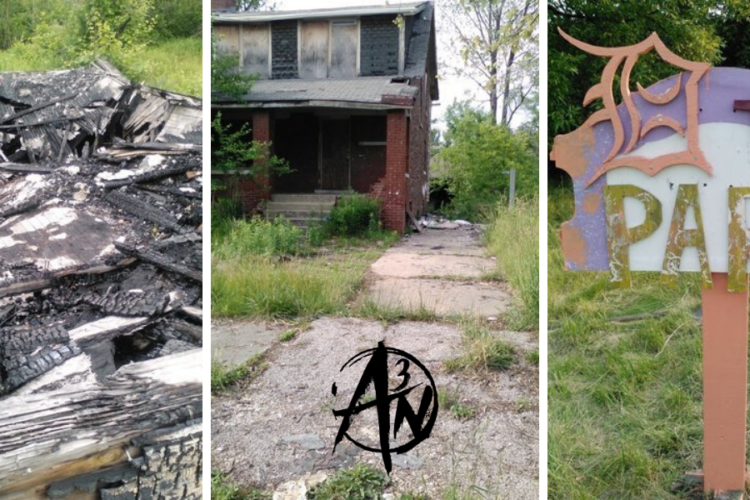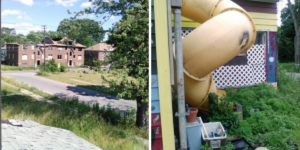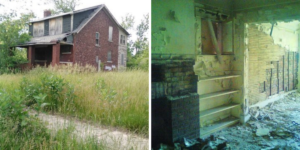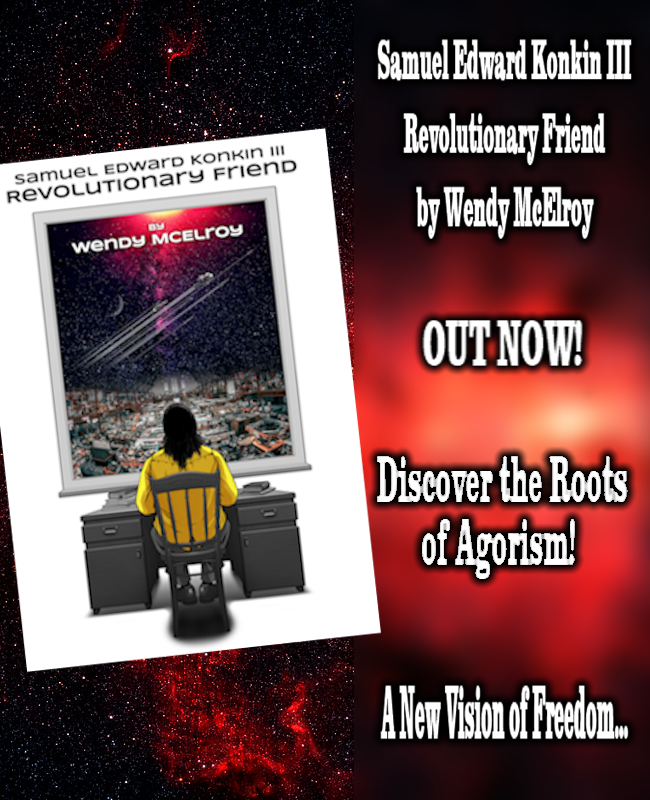
Detroit: The Unknown Agorist Haven
The time I spent in Detroit was arguably the best time I spent in the United States before leaving. It was also my only experience of living in what I considered to be an agorist community before leaving. The idea to move there came when we were already living off grid in Cleveland and being literally evicted in the middle of winter for living in a house without connected utilities. We sold our produce or products made from that produce for money and lived nearly tax free for almost 2 years before we had to move on. We saw a video on Youtube by Reason about Fireweed Universe City, and set our sights on that.
It would be the summer after that awful winter before we made it to Michigan, originally staying in some guy’s basement in the suburbs. It’s a long unrelated story as to why it took us so long but we were still moving with the intent of living the same lifestyle as before, but within that community.
Within a week of moving to Michigan, we went to Fireweed Universe City which is located just off 7 mile on W. Goldengate and W. Robinwood St. We fell in love immediately as we drove from the suburbs up by like 19 mile all the way down to 7 mile watching the scenery change from suburbs to ruins with brief blips of high class living. In that area you have high quality beautiful houses just across the street from burnt out ruins, or at least that’s what it was like 5 years ago. Likely by this point they’ve cleared even more of the abandoned houses to the ground. That was the goal of the government, just demolish the abandoned areas and leave them empty.
 The way nature was starting to reclaim that once extremely urban neighborhood was beautiful. Just a few streets down you get an idea of what those streets were once like, densely packed with the red brick Detroit tudors that are so popular in that area. The streets we lived on were mostly empty — Robinwood itself likely had less than ten houses total and one of those was a pile of charcoal and ash because of local arson. Between the shitty electric company and arsonists, most of that hood had burned down and consisted of prairie-like fields, some of which were used as gardens. The fires started with the electric company who ignored complaints like visible electricity arcs from the grid. Eventually the whole hood burned down in like one night save for a few properties which have since been reclaimed or burnt down intentionally.
The way nature was starting to reclaim that once extremely urban neighborhood was beautiful. Just a few streets down you get an idea of what those streets were once like, densely packed with the red brick Detroit tudors that are so popular in that area. The streets we lived on were mostly empty — Robinwood itself likely had less than ten houses total and one of those was a pile of charcoal and ash because of local arson. Between the shitty electric company and arsonists, most of that hood had burned down and consisted of prairie-like fields, some of which were used as gardens. The fires started with the electric company who ignored complaints like visible electricity arcs from the grid. Eventually the whole hood burned down in like one night save for a few properties which have since been reclaimed or burnt down intentionally.
Not sure if it’s still like this, especially considering many of the houses that were open are now demolished by the city (according to my investigation of that hood on google maps, this includes the house I lived in) but when I moved there it was still the type of place you could just pick an unclaimed house, move in, clean it up and it was yours. Most of us did so with the intention of buying it for super cheap at auction in the future. Several people in the community did that, they squatted until it went on sale and bought it for like a hundred dollars or something.
 You picked your house based on its issues. We picked a house that was huge but had huge roof issues because we intended on replacing the roof for solar anyway. Others go for something smaller and easier to heat because winters in the D can be cold at best. Part of our logic for our house was a fireplace (that needed repair) that we used quite a bit before we left fall of 2015.
You picked your house based on its issues. We picked a house that was huge but had huge roof issues because we intended on replacing the roof for solar anyway. Others go for something smaller and easier to heat because winters in the D can be cold at best. Part of our logic for our house was a fireplace (that needed repair) that we used quite a bit before we left fall of 2015.
From there you renovate with locally sourced materials. The empty houses and burn sites were actually an excellent source of everything from tubs to wood and nails. You could find everything you needed in that hood if you got creative, including dumped marijuana grow trash full of free soil and sometimes even free weed. That was the best. You’d wake up in the morning to giant black trash bags in the street. We’d all see them and go running to see what was inside. If you can imagine the sight often a bunch of skinny white kids running towards black trash bags in the street like there’s gold in them. As far as we were concerned, there was. Sometimes rubber gloves coated in hash from trimming, sometimes just the dirt. We always utilized what they dropped. Even the trimmings got composted. I know my compost pile was full of weed I had no hand in growing.
Beyond that there was the community, which was basically a blend of communists and agorists. Communists (with some exceptions) were generally on Goldengate, usually at the community house or Dr. Bob’s community garden. That street is also where the bottle house and slide house were featured which were more or less all communal living if I remember correctly.
Robinwood seemed to be more agorist, at least in function. These guys were starting businesses, had their own private gardens and private projects. This is also where the Detroit Anarchist Park was, which was a community park maintained and improved by everyone. By the time I left there was a grill, picnic table, pull up bar with plans of more. We used to host community cookouts, generally featuring cold Little Caesars we’d dumpster dived, stuff from the food bank or stuff from Aldi’s dumpsters. We didn’t really pay for food when we lived there, we just scavenged for it and shared with our neighbors. For a while we cooked dinner with our neighbors nearly every night either at their place or ours.
As far as finding food, homes, jobs… if you needed anything you just asked around for it. We casually asked for weed work and the news that we wanted it traveled, and we ended up with trimming work by someone coming by our squat and yelling for us. There was also a labor co-op run by some friends down the street. I got in on deck building, gardening, cleaning, roofing and all other sorts of local cash jobs and it always paid a minimum of 10 an hour cash paid at the end of the day. Between the weed work and the co-op, we made plenty of money during our time in the D. Our friend Eli used to say “If you can’t find work here, you ain’t looking.”
The weed market in Detroit, at least 5 years ago, was very much still “wild west”. Growers were buying cheap houses and growing in them sleeping on cots with guns. They hired the white kids colonizing the hood because we were the only ones to be trusted to trim the weed without stealing. They paid us well and treated us well for it. To this day one of my best “bosses” was a big dude who sat with a rolling tray on one leg and a gun on the other. He was way friendlier than he looked.
Then there was the green mile, or to be specific it was really just the Detroit side of 8 mile. See, the paradigm in Eminem’s movie shown about being born on the wrong side of 8 mile was still a thing, at least when I lived there 5 years ago. For those unaware, 8 mile is the border between the hood and the suburbs. One side (at least on the west side) was Ferndale and the other was just plain old Detroit. Now the whole Detroit side from end to end was coated in dispensaries, strip clubs and sometimes combinations of the two. It was spectacular and odd considering not one dispensary could be found on the Ferndale side. Typical agorism, finding loopholes where needed to continue operating.
I mentioned food banks but I didn’t mention that the biggest one, the one that the majority of the community depended on for sustenance (including myself) was run by the Chaldean community of the D. Much of the community was composed of illegal immigrants which made for an interesting dynamic. In the neighborhood there was this very old Chaldean man who claimed to be an illegal immigrant still and he likely was, just hanging out with the hippies of Fireweed Universe City.
See, especially in that hood, the Chaldeans are big in Detroit even to this day. They pass out huge amounts of high quality food every Tuesday or they used to at the Chaldean Cultural Center on 7 mile. Also, one of the only remaining Mom N’ Pop businesses in that area was the Chaldean butcher which I bought from regularly. To this day thinking of that place brings to mind the strong smell of middle eastern spices mingled with the smoking of their sausage we were borderline addicted to. They sold lamb and house made sausages for incredible prices so when we did buy meat, it was from there.
I didn’t know what an agorist community really was until I moved to Detroit. We lived a similar lifestyle in a house that was technically abandoned in Cleveland for almost 2 years but we were alone and the majority of the neighborhood kept their distance, confused by the hippies farming on stolen land. In Detroit it was wonderful because we didn’t have to explain the basics to these people, although we did explain agorism to them. They definitely lived it before they understood what they were doing. They just knew they were young and didn’t want to pay taxes among other things.
And they weren’t afraid to go hunting in unknown abandoned houses with us to find things like water storage containers and more. We’d flock together to houses being cleared out after estate sales like flies to honey, gleaning reclaimed stuff for our reclaimed houses. It was easily the most practical community I’ve ever lived in because of the creativity they used for things like building materials. The only other anarchist community I’ve lived in was in Acapulco, where everyone just rented their own separate properties all over the greater Acapulco area. This was much closer, more intimate. We saw and interacted with our neighbors daily, often both for work and for play.
Detroit at that time (and hopefully still) was going through a sort of Renaissance period despite the many years of drama. There was still definitely some residual danger left over from times before. The next street over was W Hollywood which was still very much full of issues. This is where the majority of prostitutes and drug dealers were. And one didn’t need to go over to Hollywood to experience some of the dangers of living there. I remember walking down the street once for a shootout to start over there. We heard bullets whiz by us as we were in the middle of the street walking to a neighbor’s.
In fact we couldn’t even live on Hollywood if we tried, because some friends did and they got chased off at gunpoint by a local dealer known as New York. They used to say “Hollywood is the dream” because it had the biggest nicest houses next to the scariest neighbors. We also still had to deal with the issue of drug dealers and prostitutes using the empty houses around us for their illegal and often gross tasks. I have a distinct memory of standing on the porch roof of my house (which was sturdy) yelling at a guy getting a blow job in his car. It took dropping rotting housing material on his car to get him to move while we yelled “people live here, move on”.
But despite all that there was a lot of progress there, especially by way of community and it wasn’t just in our little hood. By the time I left, from my understanding, even the thug known as New York was partnering with the community for things like neighborhood defense. During my time there I was meeting urban farmers all over that city that were bringing their communities together in similar ways. What I personally experienced was the white kids from the suburbs version of it. People born and raised in that area were also reclaiming the hood in ways never seen before. Recently I wrote about this for the Homestead Guru.
Much of the city was burned down or in later years straight up demolished by the city. I personally watched the city demolish several houses that had nothing wrong with them other than needing small repairs. The only good thing that comes from this is empty lots that the people have been using to feed the city.
Most people are aware that Detroit has one of the biggest food deserts out there although in recent years this is dropping drastically thanks to the presence of community gardens and urban farms. In fact, I talked to a lady once who dropped hundreds of pounds of fresh heirloom tomatoes from her urban farm on the Chaldean food drive. We definitely ate extremely well in Detroit.
My experience in Detroit was a snapshot into what life is like when government more or less just gives up. That whole Anarchy in Detroit series Reason did was extremely inspiring to us to move there. Fireweed Universe City was incredible. The Mower Gang was awesome and we saw them all over the place. Oddly enough I never encountered Dale Brown’s Detroit Threat Alliance in my time there, and neither did anyone in the community. It seemed to be more hype and advertising than actual community impact. But the thing that was really awesome to see was how anarchy could really be and how people might respond if the government truly stopped taking care of them. People with differing viewpoints living more or less in harmony. There were services for the more communistic type and for those who liked to dabble more in agorism, you were able to do so unfettered.
And perhaps the most fascinating part was the view of the police which was conflicted at best. On one hand they were friendly with us knowing we were squatters suggesting what they thought were better houses nearby for us. On the other, we had friends who described getting harassed by the police for just being there. From what I can personally tell, it was the houses with many people coming and going, communist hotbeds more or less that were being targeted. My friends on W Robinwood were building their lives and businesses without concern. It was also true that my friends who owned their houses lived on W Robinwood, not Goldengate where most of the police issues were encountered.
Prior to Mexico, Detroit is the most agorist place I’ve ever lived although I am pretty certain if you asked the majority of Detroit agorists what an agorist is, they won’t know. It’s more of an instinctual thing that happened as a result of both failing government and local economy. This somewhat lends to my theory that agorism is more natural for people because in times of stress, it’s generally agorist behavior that saves the day. The hustle to survive, so to speak.







